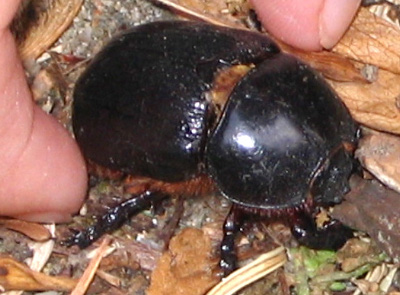European Rhinoceros Beetle
Category: Beetle

Facts about European Rhinoceros Beetles, "Scientific name for European Rhinoceros Beetle is Xyloryctes jamaicensis". This is an insect belonging to the genus Oryctes and it gets its common name due to its horn especially found on the male heads. The horn resembles the one on the Rhinos head. Males us this curved horn to fight in order to get an opportunity during mating. The horns are absent in the females. Of all the other beetles, European Rhinoceros beetle is the largest though it is less abundant species in nature compared to beetles of the same genus. Its larvae in some parts of the world are edible due to their fatty nature and are even used to produce oil in some parts of Africa. They have a high protein content. Around the coastlines, the European Rhinoceros Beetless are some of the pests, which attack palm trees. They bore holes in the trees that harbor other serious pests and thus they can be a threat to the environment.
Physical appearance and characteristics of European Rhinoceros Beetles
A mature European Rhinoceros beetle will have an average length of 2 1/4 (6 cm). The cases in the wings have a dark brown coloration. The insect uses its wings to fly and usually they fly during the dusk. Its legs are found beneath its body with the wings covering it partly. The European Rhinoceros Beetles head has a light black coloration in adults and in larva; it is pale yellow to orange. The legs as well as its abdomen are covered with long red hairs. The European Rhinoceros Beetles are the heaviest of the other beetles existent and the strongest one. They produce enormous strengths that can be 850 times more than their body weights.
Range of European Rhinoceros Beetles
This insect is a native of Europe and was first discovered in Worcestershire in UK. However, human activities have forced the insect to find new habitats. It is now known to range from north of Scandinavia to Pakistan and even some parts of Africa. It is a rare species and some countries have formulated strict regulations in order to protect the giant insect from a possible extinction.
Food of European Rhinoceros Beetles
Mature European Rhinoceros Beetless feed on sap and nectar while the larvae source its nutrients from dead matter and decaying wood. The European Rhinoceros Beetles can be found sheltering under humus, compost heaps, and under woody matter that will thus provide constant nutrients for its growth.
Reproduction of European Rhinoceros Beetles
After mating female European Rhinoceros Beetless lay large eggs that hatch into larva; however, they are not known to breed in the wild. The young larvae can easily be spotted under wood chips due to their shiny and white abdomen.
Breeding of European Rhinoceros Beetles
The European Rhinoceros beetle can be bred in the homes since it does not require much care. Adult insects should be provided with compost or sawdust where they mate. The two provisions ensure that the hatched larvae get enough nutrients for maximum growth. After eggs have hatched, the larva develops into adults after two years with the pupa taking a maximum of three weeks. In between March and May is when adults appear and they stay inactive until autumn when they start to feed. Rhinoceros Beetles can make a squeaking hissing noise. It isn't actually vocal noises. It is produced when the beetle rubs its abdomen and wing covers together.
"Scientific name for beetle is Coleoptera".

 Back To Category Beetle
Back To Category Beetle